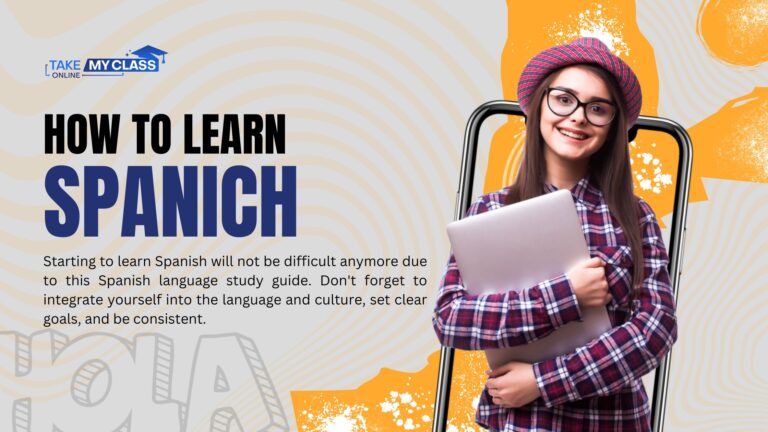
How to Learn Spanish - A Complete Guide for Beginners
The process of learning a new language is often exciting and fulfilling and if you have decided to become fluent in Spanish then this Spanish language study guide will give you everything that you need to get started. Spanish is basically one of the most popularly spoken languages in the world that presents exciting cultures, travel destinations, and career opportunities.
This is a Spanish language study guide in which we will talk about the necessary steps and strategies for learning this language, regardless of whether you are a total beginner or someone who is looking to polish up your knowledge.
Why You Need to Learn Spanish?
It is important to know why learning Spanish is so beneficial before going into the Spanish language study guide details. There are more than 460 million native speakers of Spanish worldwide which makes it the second most spoken language after Mandarin.
After English, it is most of the questions asked by students Take my online class for me in Spanish. It is one of the six official languages of the UN and the official language of 20 other countries.
Plus, point of speaking Spanish is that it can improve your travel experiences, improve your chances of finding employment, and even provide you a competitive edge in the globalized world of today. Spanish is one of the best languages to learn if you want to reach millions of people on different continents and expand your social network. Online class help is also available in Spanish.
How to Learn Spanish a Step by Step Guide?
Learning Spanish may seem overwhelming, at first but in reality, it is beneficial and enjoyable if you follow the correct approach or ask to take my online Spanish class. Here is the basic Spanish language study guide that will help you move from the start of your language learning process to a level of competence.
Clearly Define Your Learning Goals
The first step of the Spanish language study guide is to define clear and achievable goals. Consider your goals when learning Spanish. Is your goal to carry on basic conversations when you travel, or are you interested in becoming fluent? Do you want to learn Spanish for employment purposes or just for enjoyment? You can be focused by being aware of your motivation.
The first few months should be spent learning the basics of grammar and vocabulary if you are a beginner. As a beginner, you may need to ask someone to do my Spanish class online for me. You must start practicing conversation as soon as possible and move on to more difficult grammar if you want to become fluent in Spanish.
You can also see your progress by defining both short-term goals like learning ten new words every day, and long-term goals like having a 30-minute conversation in Spanish.
Learn Basic Vocabulary
Developing a good basic vocabulary is one of the most crucial initial steps of a Spanish language study guide in learning any language process. For that purpose, you can also hire online Spanish class taker to help you with this.
You will gradually find many similarities in Spanish words because Spanish and English somehow are the same, especially in fields like technology, travel, and cuisine. So, you should start by focusing on the Spanish words and expressions that you use most frequently in daily life.
As verbs, nouns, adjectives, and pronouns are usually the building blocks of your sentences then you must try to incorporate them into your vocabulary learning. A good way to start is by first learning greetings, numbers, colors, days of the week, and common verbs like “to have” (tener) and “to be” (ser and estar).
Flasan helps you to remember what you have learned. Yodigitallyse it either digital (like Quizlet or Anki) or physical.
Learn The Basics of Spanish Grammar
An important Spanish study guide is that Spanish grammar is undoubtedly tricky for beginners but it is necessary for writing consistent and accurate sentences. You must start by learning the basics such as understanding sentence structure.
Just like in English the sentence structure in Spanish is also Subject-Verb-Object. However, there are some differences such as the placement of adjectives and verb conjugations.
Learning the various Spanish tenses is one of the biggest obstacles that English speakers face. It is crucial to first focus on the present tense, future tense, and preterit tense (past tense) early on. For instance, the verb “to speak” (hablar) has various tenses.
- Present: Yo hablo (I speak)
- Preterit: Yo hablé (I spoke)
- Future: Yo hablaré (I will speak)
Moreover, there are two verbs for “to be” in Spanish: “ser” and “estar,” each has a different use. If you want to sound natural and communicate the specific meaning then you must know when to use each one.
Practice Listening and Speaking
Another important step of the Spanish study guide is to speak and listen. These are crucial skills to practice in learning any language because they will allow you to participate in conversations.
Moreover, reading and writing are also vital. Start by watching Spanish-language TV series and movies with subtitles. You can also listen to Spanish music, or listen to podcasts. This will help you quickly become more familiar with the common expressions, rhythm, and pronunciation that are used in daily conversations.
It is also crucial to practice speaking even if you have no one to talk to. You can work on your fluency and pronunciation by talking loudly to yourself. You can also more easily practice speaking with native Spanish speakers by using online language learning platforms like Tandem or iTalki which are used by many native and language learners.
An important tip of the Spanish study guide is to try to get as much access as possible to Spanish-speaking people to become fluent in Spanish. You can significantly practice what you have learned in authentic settings by visiting Spanish-speaking countries or talking with Spanish speakers in your area.
Use Apps for Language Learning
Worldwide technological advancement has affected numerous aspects of daily life. The use of technology in the traditional classroom already enhances the student’s and institution’s educational experiences.
There are tons of Spanish study guide and language-learning applications available in the current digital era in order to help you with your Spanish studies.
These apps use various strategies to help you see what you have learned including games, quizzes, and spaced repetition.
Well-known apps like Duolingo, Babbel, and Memrise assist you with grammar and vocabulary, while Lingoda or Flfocuses focus more on improving your speaking and listening skills. You can regularly practice Spanish anytime by incorporating these apps into your daily routine.
Interact With Spanish-Speaking Communities
One of the most effective ways to improve your Spanish is to interact in their community. Participate in Spanish-speaking online communities for example forums, social media groups, or language learning platforms in order to communicate with native speakers and other students.
By doing so you will also see that you have become more proficient in writing, understanding, and cultural awareness. Talking with others also gives you the confidence and motivation that you need to stick with your learning goals.
There are also various communities that organize events, online gatherings, or chat rooms where you can practice your Spanish in a more relaxed setting.
Stay Consistent and Patient
Keep in mind that it takes lots of time and effort to learn a new language especially a language like Spanish. The secret to learning any language quickly is to have it consistently.
It will be more useful to practice frequently than to wait for hours once a week. Do it if even you only have ten to fifteen minutes each day. Whether you are in the phase of learning new words, talking with a language partner, or listening to a podcast, you should importantly make learning Spanish your daily habit.
Important tip of the Spanish study guide is to remember to have patience in yourself while learning. Moreover, it’s normal to experience difficulties like having trouble remembering vocabulary or conjugating verbs. Instead, you will gradually see and progress as long as you remain motivated and consistent.
Take Part in Spanish Culture
Learning a language includes more than just learning grammar and vocabulary but it also includes adopting into the language’s culture. Spanish-speaking peoples have rich and varied traditions, art, cuisine, and histories. Gaining knowledge of Spanish-speaking countries and their subtle cultural differences can give some context to your language-learning process.
Travel to countries where Spanish is the primary language, cook Latin American or Spanish cuisine or go to festivals and cultural events. This will encourage learning and will strengthen your bond with the language.
Monitor Your Progress
Monitoring your progress is essential for maintaining motivation and focus in the whole learning process. Keep a detailed journal of your progress, new vocabulary, and grammar rules. Use apps for language learning that keep track of your achievements like lessons finished or streaks.
Test your skills or learning process on a regular basis by taking quizzes or having discussions with native speakers. The learning process can be more fulfilling when you admit your even small achievements in this process because it can increase your confidence and help you highlight the areas that require improvement.
Be Ready to Make Mistakes
A necessary and inevitable aspect of learning a language is making mistakes. Important advice from the Spanish study guide is to not be demotivated by mistakes you must see them as opportunities for improvement.
Think like every error you make teaches you something new, whether it is related to mispronouncing a word or using incorrect tense. By doing so will eventually make you more confident and also native speakers will appreciate your efforts.
Even if you are not perfect, remember that the important thing is to keep practicing, have patience, and not be ashamed of speaking wrongly. Cement it, errors are just stepping stones toward achievement.
Conclusion
Starting to learn Spanish will not be difficult anymore due to this Spanish language study guide. You will be speaking Spanish with confidence very quickly if you have the correct mindset and Spanish language study guide. You now have the Spanish language study guide, resources, and tools that you will need to get started with your Spanish language learning.
Moreover, you now have tips on how to improve your grammar, expand your vocabulary, and practice speaking and listening. Don’t forget to integrate yourself into the language and culture, set clear goals, and be consistent. With each step you will get closer to mastering Spanish.
Frequently Asked Questions
How Much Time Does Learning Spanish Take?
Effort and consistency determine how long the learning process will take. However, beginners can achieve fluency in Spanish after 6-12 months of practice.
What Is the Most Effective Way to Improve Your Spanish Speaking Skills?
Effective strategies to improve your speaking skills include practicing with native speakers, participating in language learning platforms, and going to local or virtual gatherings.
Does Learning Spanish Require Me to Visit a Spanish-Speaking Country?
Traveling is not necessary but it helps in learning quickly. There are many options for efficiently learning Spanish from any location due to local communities, language apps, and online sources.
What Is the Hardest Thing About Learning Spanish?
Many students struggle with verb conjugations and grammar especially when it is about identifying the difference between tenses. However, after some time, these difficulties become manageable with regular practice and study habits.
The Best Price Offers You’ve Seen
| Full Class | $ 99/ Week |
| Homework | $ 79/ Week |
| Test or Quiz | $ 99/ Week |
| Essay or Paper | $ 39/ Week |
| Project | $ 99/ Week |
